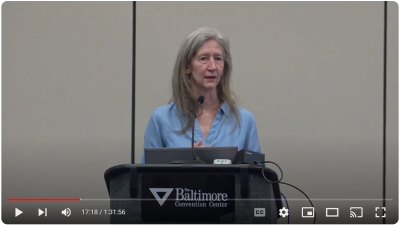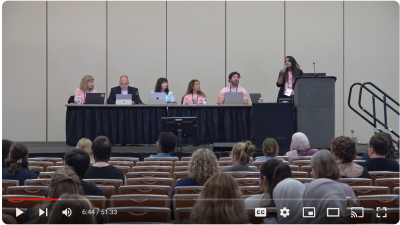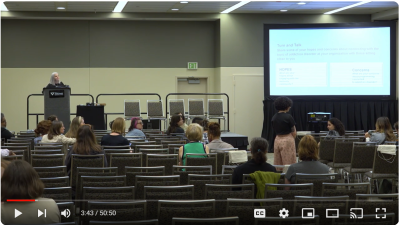I hope you’re planning to get together with colleagues to share “Feeding the Spirit: Museums, Food & Community,” CFM’s free webinar on Feb. 17, and explore food literacy, values-based food service and community building.
If you’re still mulling over the webcast menu, I bet this guest vlog (video blog!) from Eliza Fournier will convince you to join us at the table.
Eliza shares how the Chicago Botanic Garden uses its Green Youth Farm and other garden-based programs to integrate food into their operations, get visitors excited about conservation and mentor the next generation of museum staff. (Which, incidentally, also builds a more diverse staff, thus helping to address the demographic challenge facing museums.) She also explains why Feeding the Spirit (originally a symposium, now a webinar) is so useful.
Are you interested in implementing a youth garden at your museum? Eliza shares the Chicago Botanic Garden’s “recipe for success” in the webcast’s discussion guide, the “Feeding the Spirit Cookbook.” Here is a sneak peek, sharing Eliza’s recipe
Skip over related stories to continue reading articleRecipe for Success: Youth Engagement with a Side of Sustainable Farming
Chef: Eliza Fournier, green youth farm manager, Chicago Botanic Garden
Description:
This tasty recipe will yield a holistic youth development program, using sustainable agriculture practices, that includes: cooking, nutrition, leadership development and work-readiness skills mixed in with a little old-fashioned farm work.
The Chicago Botanic Garden has been involved in community gardening outside the walls of its Glencoe site for its entire history. Since 2003, it has deepened its connection with the community through its Urban Agriculture programs, which include the Green Youth Farm initiative for youth and the Windy City Harvest certificate program for adults. Green Youth Farm consists of four off-site sustainable agriculture (small) farms, each of which employs 20+ high school students mid-May through mid-October. Participants experience life on the farm while gaining an appreciation for how their food is produced, harvested and marketed to patrons of the Chicago Botanic Garden and members of their communities.
Ingredients for Success:
- Leadership: No substitutions for this ingredient. You must have highly inspired and committed internal leaders to “raise the dough” and provide the institutional support needed to support this effort year after year.
- Space: You need fertile soil in which to grow your gardens (and students). This can be on-site or off-site on park/forest preserve, school or purchased land. Important ingredients include access to water, office space and fencing. If your space is on urban land, make sure to utilize raised beds to avoid growing in contaminated soil, which can spoil the recipe.
- Staff: At a minimum, one full-time/year-round staff member to run the program. This is a painstaking and complex recipe that takes committed and skilled staff whom you will want to have around for the long term. The best quality staff people for this recipe will have experience in working with youth, farming and team-building/program delivery. To serve 25-30 students on a ¾- to 1-acre site, we recommend one full-time/year-round coordinator, one full-time seasonal grower (six months) and two full-time seasonal interns (three months).
- Curriculum/plan: Fortunately, lots of people have made this recipe before, so there is a wealth of information and training available to people who are attempting this dish for the first time.
Instructions:
- Raise the dough. This can be done through the institutional budget or through outside fundraising from corporate sponsors, individual donors, family foundations and/or government grants. A diverse mix of these sources will yield the optimal flavor balance.
- Hire the staff. The pool of candidates with the right mix of personality, experience and education is ever-growing. There are many on-line resources that can help you recruit quality staff for your recipe, including ATTRA (or National Sustainable Agriculture Information Service) and Slow Food USA.
- Gather available curriculum/program materials. Maybe even participate in some training with an experienced “chef” to make sure you understand the steps to this recipe.
- Identify the land where you will create this recipe. Is it on or off-site? Does it have the key qualities listed above? Do you have long-term permission to use the space? (Note: Steps 1–4 can be performed simultaneously or in reverse order. Sometimes it’s best if step 4 happens first to avoid future conflicts!) If the land is off-site, identify community partners who may already be doing similar work and who may be able to help you: a) identify staff and/or students from within the community to participate in the program, b) help provide pieces of the recipe you do not feel so confident about, c) procure or share resources such as gardening materials, advice, etc.
- Develop a site plan. Make sure to include raised beds if you are planting in urban soils!
- Recruit students. Participating in high school career days or just setting up a booth during lunch are great ways to raise interest.
- Build your garden. It is great to include high school students in the initial construction of the garden. (Note: Don’t fret about yields in your first year. The most important produce is your students and the built farm.)
- Repeat and add your own special ingredients to make the resulting recipe your own unique blend!
Notes on Technique:Recipe has the tendency to double, triple and quadruple! Sustainable food systems are a very popular topic right now, and if done right, people experiencing your recipe will undoubtedly want more. Consider how much you are willing to undertake before embarking on the adventure that is this recipe.
The key ingredient in this recipe is staff. The right (and enough) staff with the right skill sets will help you avoid having to redo this recipe over and over.
There are great opportunities for institutional synergies in this recipe. Youth participants can grow food for your museum’s café and support your museum’s gift shop through value-added products (food and other products, e.g., cookbooks, etc.). Today’s youth participants are tomorrow’s museum employees. Field trips for discussion with museum staff about careers help make our museums even more accessible to the communities we serve. Youth are advocates for our museums. They help inspire folks who previously may have never heard of our institutions.
More Information:
- For the Chicago Botanic Garden’s interpretation of this recipe, visit www.chicagobotanic.org/greenyouthfarm.
- For the original recipe (including curriculum and manuals) that we adapted for our use, visit www.thefoodproject.org.
Register for the Feeding the Spirit webinar now to ensure you receive the Feeding the Spirit Cookbook: A Resource and Discussion Guide on Museums, Food and Community. We encourage you to host a potluck at your museum and participate in the webinar as a group, using it as a jumping off point to explore how your museum can help improve food literacy, incorporate mission-related values into your food service and use food to reach new audiences.
This webinar incorporates content presented at the “Feeding the Spirit” symposium hosted at the Phipps Conservatory and Botanical Gardens in Pittsburgh, Penn. on October 13, 2011. The webcast is made possible by the generous support of our host, LearningTimes.
Feeding the Spirit, the symposium and webcast, is the result of collaboration between AAM’s Center for the Future of Museums, the Association of Children’s Museums, the American Public Gardens Association, Phipps Conservatory and Public Garden and the Carnegie Museums of Pittsburgh, with the generous support of presenting sponsor UPMC Health Plan and Sodexo.









Comments